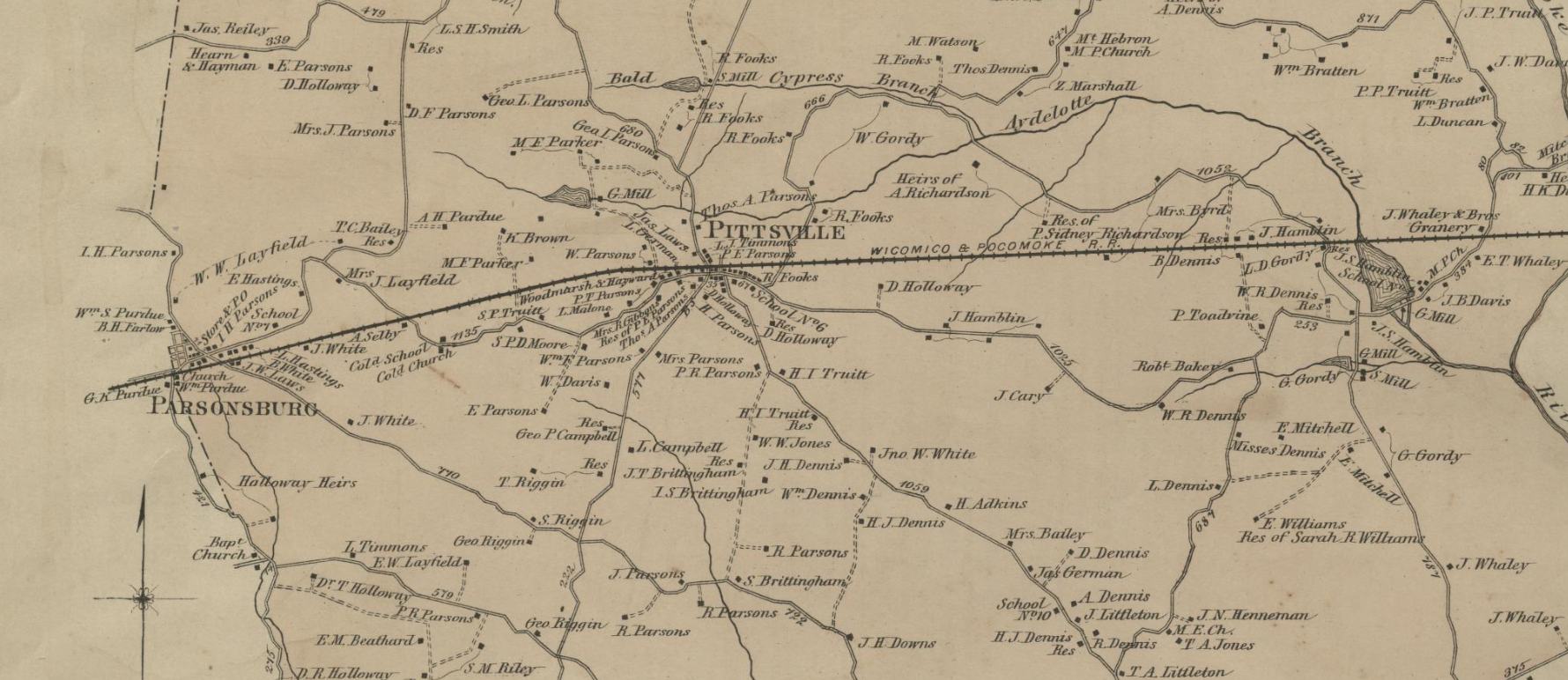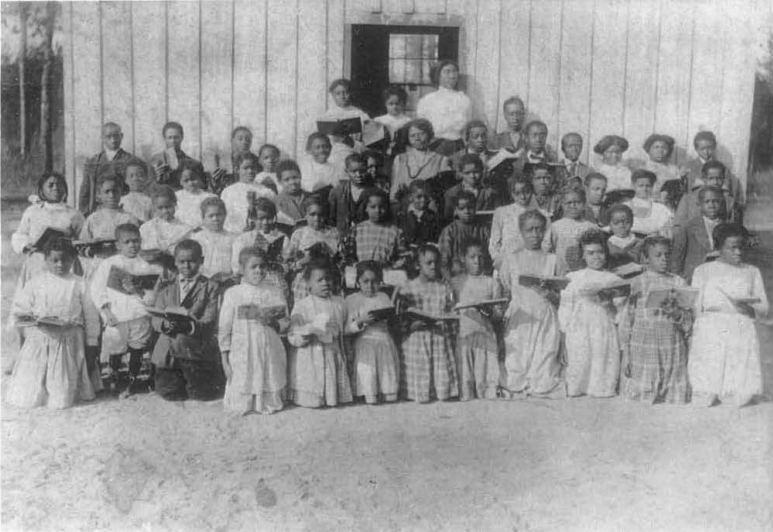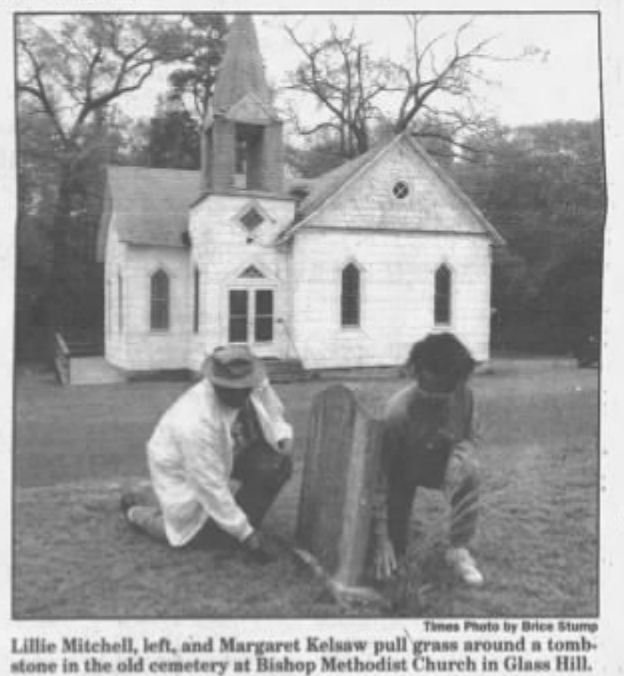|
Story by Andre Nieto Jaime Pittsburg District in the 1877 Atlas of Somerset, Wicomico, and Worcester Counties Internet Archive 1877 Tucked in between Parsonsburg and Pittsville in Wicomico County is a small, nearly forgotten community that goes by the name of Glass Hill. When asked, most people likely do not know of its existence nor would they say anything stands out about Glass Hill, aside from the old church and cemetery. This small village is part of Parsonsburg and blends seamlessly into its surroundings. Consisting of a combination of mobile homes and family homes, no one would suspect that this branch of Old Ocean City Road was a Black community with ties going back to the 19th century, possibly even the late 18th century. However, despite emerging around the same time as, or perhaps predating, Derrickson’s Crossroads, Glass Hill and Black rural Wicomico County receive little representation in historical discussion. Yet, Black residents contributed to the history and development of rural towns, like Pittsville and Parsonsburg, which deserves recognition. 1877 Atlas of Somerset, Wicomico, and Worcester Counties Pittsburg District Internet Archive 1877 According to the few remaining residents of Glass Hill in a 1996 article of The Daily Times, Glass Hill’s history dates back as early as the late 18th century as a free Black community. The village’s population continued to grow over the course of the 19th century and after the Civil War, in 1866, a church was built. However, according to the church’s history, it was not named until the 1890s. This very church appears in the Wicomico, Somerset & Worcester Counties Atlas from 1877 as “Cold [Colored] Church” and was later named Bishop Methodist Church in honor of Civil War veteran Jacob Bishop from the community. The Maryland Historical Trust Inventory of Historic Properties refers to the church as “Cavalry M.E. Church” and describes the building as having been built in 1909 because of the inscription on the church’s southeast corner. However, the east side of the corner stone also bears the inscription “Founded in 1872” suggesting that the church may have been remodeled after its initial construction. M.E. Cavalry Church/ Bishop Methodist Church Maryland Historical Trust WI-503 Across from Bishop Methodist Church on the 1877 Atlas was a building labeled “Cold [Colored] School” which was the Glass Hill School, a single room schoolhouse for Black children. According to the Maryland Historical Trust’s Inventory form on the school, it was built around 1870, not long after the construction of the community’s church, and had a lengthy career in educating the children of Glass Hill and surrounding area. According to several articles, such as a 2008 edition of Shoreline, Glass Hill School was home to the first male teacher in Wicomico County, Emerson C. Holloway of Delmar. Glass Hill School also allegedly was where activist Ronald Everett (Dr. Maulana Karenga) attended school. However, a combination of factors go against this claim. References to the school as an active school began declining in the 1940s and the school itself was moved to and restored in Pittsville in the later part of the century. Additionally, an article from 1943 mentions the sale of the Glass Hill School property by the Board of Education of Wicomico County. Finally, the fact that Everett was born in 1941, makes this claim seem to be an extrapolation of the fact that he grew up in Parsonsburg and Glass Hill. Glass Hill School in Glass Hill Delmarva African American History Class Photo Maryland Historical Trust WI-496 Glass Hill School Now in Pittsville 2023 Glass Hill and the schoolhouse also served as the birthplace of the Seventh Tabernacle in Salisbury when its founder, John Elzey Parker, came to visit his sister, Jennie Parker, in 1921 and established his congregation in Glass Hill. Both homes and the Glass Hill School were used to hold services until the congregation moved to Salisbury where it remains active. The construction of the Bishop Methodist Church and the Glass Hill School after the Civil War give the impression that this was a growing community at the end of the 19th century and into the early 20th century with the establishment of the Seventh Tabernacle. The community was even slated to get its own Rosenwald School in 1929. According to the United States Department of the Interior National Park Service National Register of Historic Places Multiple Property Documentation Form on Rosenwald Schools in Maryland from 2014, the final year of Rosenwald School construction was set to be in 1929-1930, with fifteen schools across Maryland being built in this final period of the Rosenwald School Building Program. Glass Hill was among the 15 schools listed in this Property Documentation Form. Searching through land records reveals that in August of 1929 one acre of land was given to the Wicomico Board of Education with the property being named “Wicomico County School Lot Glass Hill” suggesting that this lot was meant to be used for the construction of a Rosenwald School on Old County Road. This transaction was also published in The Daily Times the same month, noting that the Board of Education of Wicomico obtained one acre in the Pittsburg District for the consideration of $10 from Sarah Parker. However, as a future StoryWay will reveal, it is unlikely that this school ever managed to be built. Wicomico County School Lot Glass Hill Wicomico County Circuit Court Plats Microfilm 1929 By the latter half of the 20th century, it seemed that Glass Hill was unfortunately beginning to decline. The 1996 interviews mention how the old homes of Glass Hill were gradually being replaced with mobile homes as the old residents passed on or moved away. Land sales also have contributed to the dwindling of the community. Bishop Methodist Church was not spared from this decline either, with its congregation shrinking to about 15 members by the end of the 20th century. The Great Depression is credited with causing the exodus out of Glass Hill according to the residents. Lillie Mitchell and Margaret Kelsaw Pulling Grass from around Tombstone Times photo by Brice Stump c. 1996 Today, not much remains to remind people that this was once a growing Black community, with only the church and cemetery serving as a reminder of this village’s history. Although, those too face the danger of being forgotten give their current states. Racial barriers not only physically separated Glass Hill from Pittsville and Parsonsburg but have also separated their history from these towns. To preserve the memory of this town and give its residents the recognition that they deserve, several StoryWays will be published delving into the history of Glass Hill as a way of solidifying Glass Hill as a community that grew alongside Pittsville. References: Primary Sources
“Answer to Today’s A Moment in Time.” The Daily Times, February 9, 1998. Atlas of Wicomico, Somerset & Worcester Cos., Md. Philadelphia: Lake, Griffing & Stevenson, 1877. “Building Shore History.” The Daily Times, March 27, 2004. “Deeds Recorded.” The Daily Times, August 16, 1929. “Notice.” The Daily Times, April 14, 1943. Wicomico Co. School Lot Glass Hill. Land Records IDT 158, p. 585 MSA S1548-1062, Wicomico County Circuit Court, Salisbury, MD. https://plats.msa.maryland.gov/pages/unit.aspx?cid=WI&qualifier=S&series=1548&unit=1062&page=adv1&id=1393454667. WI-503 Calvary M. E. Church Architectural Survey File, 29 August 2003. Maryland Historical Trust Maryland Inventory of Historic Property Form Inventory No. WI-503, Maryland Historical Trust, Crownsville, MD. https://apps.mht.maryland.gov/medusa/PDF/Wicomico/WI-503.pdf. WI-496 Glass Hill School Architectural Survey File, 29 August 2003. Maryland Historical Trust Maryland Inventory of Historic Property Form Inventory No. WI-503, Maryland Historical Trust, Crownsville, MD. https://apps.mht.maryland.gov/medusa/PDF/Wicomico/WI-496.pdf. Secondary Sources: Duyer, Linda. “Wicomico County’s Seventh Tabernacle.” Delmarva African American History. Accessed January 2, 2024. https://aahistorydelmarva.wordpress.com/2013/10/03/wicomico-countys-seventh-tabernacle/. National Register of Historic Places Multiple Property Documentation Form “Rosenwald Schools of Maryland.” Maryland’s National Register Properties, Maryland Historical Trust, Crownsville, MD. https://apps.mht.maryland.gov/nr/NRMPSDetail.aspx?MPSId=25. “Remembering the One-Room Schoolhouse.” Shoreline, September 9, 2008. “Seeing Through Time in Glass Hill.” The Daily Times, May 14, 1996.
0 Comments
Leave a Reply. |
Archives
July 2024
Categories |









 RSS Feed
RSS Feed
